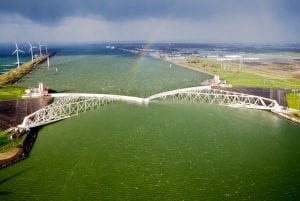Reporter and Associate Editor for The Texas Tribune
 In this issue’s Q&A, Texas+Water Editor-in-Chief, Dr. Todd Votteler, interviews Kiah Collier. Kiah Collier is a reporter and associate editor for The Texas Tribune, with a focus on energy and environment. Collier has reported for publications across Texas over the past decade, including the San Angelo Standard-Times, Reuters, the Austin-American Statesman and the Houston Chronicle. Her reporting has garnered a variety of local, state and national awards, including a Peabody in 2017 for her work on a project that examined the Houston area’s extreme vulnerability to hurricanes. She is a graduate of the University of Texas at Austin.
In this issue’s Q&A, Texas+Water Editor-in-Chief, Dr. Todd Votteler, interviews Kiah Collier. Kiah Collier is a reporter and associate editor for The Texas Tribune, with a focus on energy and environment. Collier has reported for publications across Texas over the past decade, including the San Angelo Standard-Times, Reuters, the Austin-American Statesman and the Houston Chronicle. Her reporting has garnered a variety of local, state and national awards, including a Peabody in 2017 for her work on a project that examined the Houston area’s extreme vulnerability to hurricanes. She is a graduate of the University of Texas at Austin.
What inspired your interest in water, and when did you start covering water issues? How long did it take you to master the unique aspects of Texas water?
My first job out of school was at the San Angelo Standard-Times in West Texas, where I covered city and state government. That was about a year before the devastating 2011 drought. The city was totally dependent on reservoirs for drinking water and they were rapidly evaporating. At one point, it had about 12 months of water left. As you can imagine, it was a big focus for the city council. At the same time, the first big fracking boom was ramping up in the region and energy producers were using a massive amount of fresh water. People’s water wells started running dry. In reporting on all of that, I came to learn about Texas water law and how complicated it is. I would say it took me a few months of constantly interviewing attorneys and water experts and reading books to really feel like I had a firm grasp of it—but I still feel like there are things I don’t know!
What inspired you to travel to the Netherlands to see the Dutch approach to flood prevention and mitigation? What has been the reaction to the story that resulted from your trip?
For years now, I’ve been reporting on a policy and scientific debate about how best to protect the Houston-Galveston region from hurricanes. Researchers started sounding the alarm after 2008’s Hurricane Ike, saying that storm modeling showed the storm—already the costliest in state history at the time—could have been significantly worse if it had hit just a few miles down the coast, near the western end of Galveston Island.

One of those researchers, Bill Merrell of Texas A&M University at Galveston, unveiled a storm protection plan a few months after Ike. Nicknamed the “Ike Dike,” it was very much inspired by a world-renowned system in the Netherlands that has successfully helped guard the extremely low-lying country from North Sea surges. (No one has died in a flood there in 66 years!) A few years later, after much pressure from Merrell and researchers at Rice University, who have proposed their own storm protection plans over the years, the state and local government launched a formal study. And the project they’re now looking at looks a lot like the Ike Dike. Point being, the Dutch system is now officially relevant. So when I got an invitation from A&M to embed with a group of students who were going over there to learn about it, I said yes. (After getting the green-light from my editors, of course.)
The Netherlands is moving away from relying solely on structural solutions to flooding and is incorporating more nature-based solutions such as the “Room for the River” project you referred to in your article. Do you think that potential solutions to flood impacts in Texas such as the Ike Dike are behind the curve in focusing too much on structural solutions?
If you ask people like Merrell or even government officials about this, they’ll tell you that there is room for all of those solutions—they refer to it as “multi-line defense” —but that blocking storm surge at the coast is the most important thing to accomplish. One of Merrell’s fellow researchers at A&M, Sam Brody, told me he had been skeptical of the Ike Dike concept at first because he’s a big believer in more nature-based solutions to prevent flooding (mainly inland, rain-based flooding, which is a different issue), but he’s now convinced of that, too.
While reporting the story, I ran across this really incredulous essay by a Dutch social scientist that said the Netherlands is now able to focus on these romantic, nature-based solutions only because it has already manipulated nature. Certainly, there are major environmental concerns about the Ike Dike and a lot of people are really skeptical that it’s worth it. But other people say the environmental impacts it will have pale in comparison to those a worst-case storm would cause.
It should be noted that the US Army Corps of Engineers and the Texas General Land Office are now looking at putting fortified sand dunes along Galveston Island and Bolivar Peninsula rather than a big, concrete levee along the main roadways there, which is what they had initially proposed. The main concern is with the storm surge gate system they want to install between Galveston and Bolivar because it would hinder an interchange of water between the bay and the Gulf that is crucial for marine life.
Which of your articles on Texas water are you most proud of?

I think I’m most proud of how thorough and prolific my coverage of water issues has been over the years. In San Angelo, I recall writing about water issues on a weekly basis for at least a year and I got so many reader emails thanking me for keeping them informed [Texas’ second oil boom costs precious water and Amid drought, Irion County residents concerned about use of fresh water for hydrofracking].
That said, I’d have to say my longstanding favorite is the first, big story I did in San Angelo that exposed how much water energy producers were using to frack during such a bad drought. That story and subsequent follow-ups got the attention of statewide and national publications, which sent reporters to the area to write stories that looked a whole lot like the ones I had already published.
Which Texas water story surprised you the most when you were researching it?
When I first started reporting on people’s water wells going dry out in West Texas during the 2011 drought, rule of capture obviously came up, and that concept is always mind-blowing to people who don’t know about it, and it was mind-blowing to me at the time (see links to articles in previous answer). Of course, it doesn’t apply in places that have groundwater conservation districts, but GCDs are also really limited in enforcing it and many in West Texas continue to approve pumping for industrial uses more than some think they should. But what are you supposed to do when you basically have no enforcement authority?
Which Texas water story troubled you the most?
The potential threat to the San Solomon Springs from the oil and gas production has been troubling because of the beauty and uniqueness of Balmorhea swimming pool. Apache Corporation swears it’s being really careful about it, but it’s still unnerving. Well casings don’t always work, and the area is particularly vulnerable to groundwater contamination because it sits atop an aquifer encased in karst.

Do you see significant differences in your reader’s interest in water quality stories as opposed to water quantity stories?
Yes. When a drought fades, so does reader interest and, therefore, coverage. That said, stories I’ve written in recent years on reports that expose water contamination—particularly in rural areas that can’t afford to upkeep water treatment facilities—have gotten a lot of page views. I think people care about both, but certainly running out of water is a much freakier concept to people.


Thanks for transcription! This helps us get the information quickly. Sad to say, but the average non-scientist likes to spend about 5 to at most 10 minutes on a story, since the average person does not devote his or her time to water issues. There is a role for in-depth coverage, to be sure, but there is also a role for pithy stories to capture the interest of the average person working in a field having nothing to do with water, and in raising their interest in the importance of water management. Maybe some shorter versions along with longer versions of podcasts may be helpful for the average person with a tight summary of the high points that the average person may want to know. I realize this would entail extra work, and may not be feasible, but 5-7 minute podcasts are much more likely to be listened to by more people than the “inner circle”, so to speak. May be easier to develop the “nutshell” podcast after doing the full version. You could advertise the short time of these podcasts with a catchy name involving water to capture people scanning the email magazine. Thanks, that’s my suggestion.